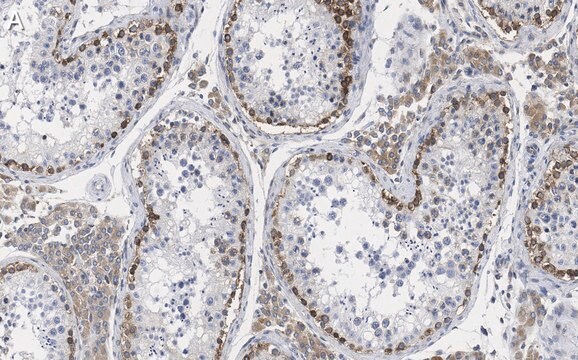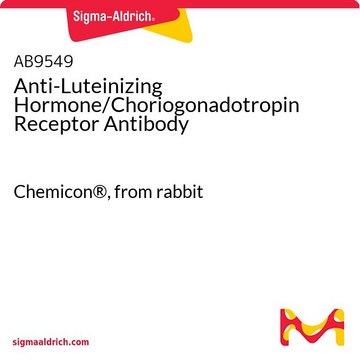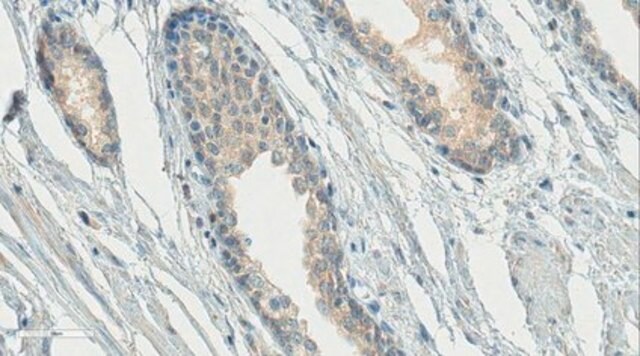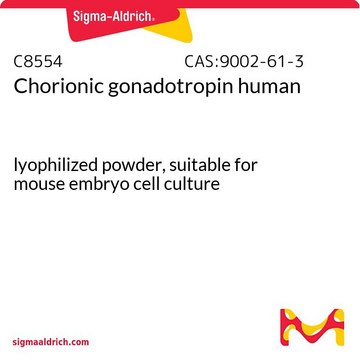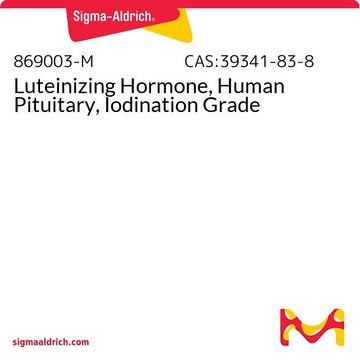MABN1794
Anti-GnRH-R Antibody, clone F1G4
clone FIG4, from mouse
Sinônimo(s):
Gonadotropin-releasing hormone receptor, GnRH receptor, GnRH-R, Leutinizing hormone-releasing hormone receptor, Luteinizing-releasing hormone receptor
About This Item
Produtos recomendados
fonte biológica
mouse
Nível de qualidade
forma do anticorpo
purified immunoglobulin
tipo de produto de anticorpo
primary antibodies
clone
FIG4, monoclonal
reatividade de espécies
human
técnica(s)
ELISA: suitable
dot blot: suitable
flow cytometry: suitable
immunohistochemistry: suitable (paraffin)
western blot: suitable
Isotipo
IgG1λ
nº de adesão NCBI
nº de adesão UniProt
Condições de expedição
wet ice
modificação pós-traducional do alvo
unmodified
Informações sobre genes
human ... GNRHR (2798)
Descrição geral
Especificidade
Imunogênio
Aplicação
ELISA Analysis: A representative lot detected the immobilized immunogen peptide by ELISA (Karande, A.A., et al. (1995). Mol. Cell. Endocrinol. 114(102):51-56).
Flow Cytometry Analysis: A representative lot detected surface GnRH-R immunoreactivity on live human breast carcinoma T47D and ovarian carcinoma OVCAR-3 cells. Most likely due to low affinity antibody binding or unoptimized antibody concentration used, only ~50% of the T47D and ~10% of the OVCAR-3 populations were stained (Karande, A.A., et al. (1995). Mol. Cell. Endocrinol. 114(102):51-56).
Immunohistochemistry Analysis: A rerepsentative lot detected GnRH-R expression on gonadotropin-producing endocrine cells (gonadotropes) in pituitary, as well as among neurons in human hippocampus and neocortex, using formalin-fixed, paraffin-embedded human tissue sections (Wilson, A.C., et al. (2006). J. Endocrinol. 191(3):651–663).
Immunohistochemistry Analysis: A rerepsentative lot detected similar hippocampus GnRH-R immunoreactivity among Alzheimer′s diseased (AD) and age-matched control brain sections, while significanly decreased GnRH-R immunoreactivity associated with the apical dendrites of pyramidal neurons was seen in the AD brain using formalin-fixed, paraffin-embedded tissue sections (Wilson, A.C., et al. (2006). J. Endocrinol. 191(3):651–663).
Immunohistochemistry Analysis: A rerepsentative lot detected GnRH-R-positive cells in the anterior pituitary, but not the posterior pituitary using frozen human brain sections. Pre-blocking with immunogen peptide abolished the antibody staining (Karande, A.A., et al. (1995). Mol. Cell. Endocrinol. 114(102):51-56).
Western Blotting Analysis: A rerepsentative lot detected the expression of multiple GnRH-R variants in human cortex and pituitary tissue lysates, including the most prominent 30 kDa, 64 kDa, and 136 kDa bands. The 136 kDa band was seen significantly downregulated in the cortex, but not pituitary from Alzheimer′s diseased (AD) brain when compared to age-matched control (Wilson, A.C., et al. (2006). J. Endocrinol. 191(3):651–663).
Neuroscience
Hormones & Receptors
Qualidade
Western Blotting Analysis: 2.0 µg/mL of this antibody detected GnRH-R in 10 µg of human pituitary tissue lysate.
Descrição-alvo
forma física
Armazenamento e estabilidade
Outras notas
Exoneração de responsabilidade
Não está encontrando o produto certo?
Experimente o nosso Ferramenta de seleção de produtos.
Código de classe de armazenamento
12 - Non Combustible Liquids
Classe de risco de água (WGK)
WGK 1
Ponto de fulgor (°F)
Not applicable
Ponto de fulgor (°C)
Not applicable
Certificados de análise (COA)
Busque Certificados de análise (COA) digitando o Número do Lote do produto. Os números de lote e remessa podem ser encontrados no rótulo de um produto após a palavra “Lot” ou “Batch”.
Já possui este produto?
Encontre a documentação dos produtos que você adquiriu recentemente na biblioteca de documentos.
Nossa equipe de cientistas tem experiência em todas as áreas de pesquisa, incluindo Life Sciences, ciência de materiais, síntese química, cromatografia, química analítica e muitas outras.
Entre em contato com a assistência técnica

